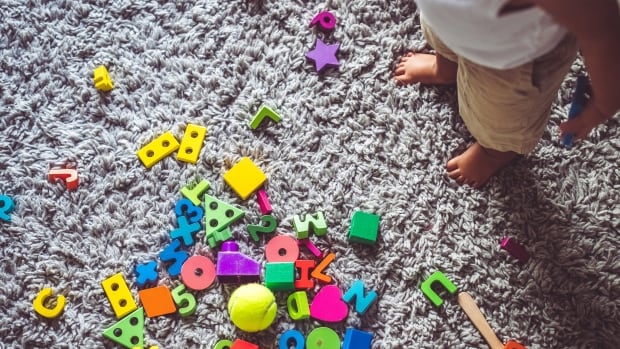‘Living room families’ embrace the mess to stay close to their kids. But is it a trend or a guilt trip?
If you:
- Have stepped on so many Lego pieces over the years that you’ve become immune to the pain and perhaps grown a thick, leather-like skin on your heels as a form of protection;
- Routinely sweep aside a heap of board books, Elsa dolls in various states of undress, a broken Slinky, a discarded birthday party loot bag, and a so-beloved-it-must-remain-indoors stick collection just to sit down;
- Eat dinner in view of an overstuffed Ikea storage shelf that is packed so full of Hot Wheels and train tracks the drawers don’t close;
- Have said “the couch is NOT a jungle gym, oh, fine, just don’t come crying to me when you bonk your bean,” hundreds of times, and then soothed the small human who comes crying to you when they do, in fact, bonk their bean…
Then you might be a modern parent … and, you know, a touch of a mess. But take heed, there’s a trending term to make you feel better about the state of your home. You might just be a living room family.
What in the “race-tracks-winding-around-my-dining-room-table” hell is that you ask?
According to social media and parenting news articles, “living room families” tend to congregate in one common area of the home, like a living room or den.
“Bedroom families,” on the other hand, are where parents escape the noise of their children in their own off-limits rooms, or where kids are expected to play out of sight in theirs.
Millennial and Gen X parents are increasingly posting online about how they’re breaking the generational pattern between their upbringing in a bedroom family and how they’re raising their own children.
The idea is that “families who spend most of their time together in the communal living spaces of their home do so because everyone feels safe, at peace, comfortable and accepted enough to do so,” writes Instagram influencer MindfulMagda.
“I’m breaking a generational curse I didn’t realize was there,” writes TikTok user “Sunny” on a video with more than 1.4 million views.
“I’m Gen X and in our day kids were to be seen and not heard. We could be in the living room but not our toys or loudness, just to watch TV as a family,” wrote a commenter on another video posted Oct. 26.
“Realizing I have living room children is the biggest compliment that I could ever receive as a parent desperately trying to break the cycle,” writes mommy blogger Filipa Jackson in a TikTok video with more than 386,500 likes.
Canada’s birth rate is among the lowest low. Why aren’t people having as many children? CBC sat down with three women to talk about their decision.
Modern families, modern problems
The terms “living room” and “bedroom” families may be new but the concepts really come down to modern versus traditional, says Julie Romanowski, a parenting coach and consultant based in Vancouver.
A traditional family or parenting style is more structured and rule-based with defined roles — think, parents work (or maybe one stays home), kids go to school, everyone has dinner at the table and then goes to their rooms to do homework, watch TV, or maybe play outside. Not alone, per se, but more separate.

In modern families, both parents might work long hours, or do shift work, or drive their children around to ballet, soccer, French lessons and playdates, Romanowski said. They might eat dinner in the car, or the kids might eat on the couch while the parents try to wrap up a work project, empty the dishwasher or just take a breath before someone dumps a puzzle on the floor, declares the floor is lava, or pulls out the Marble Run pieces.
“Life is just so busy that families adapted to living with the busy,” Romanowski said.
But experts have noted that investing all your available time and energy into your children isn’t necessarily better for anyone. And not everyone is on board with the idea that “bedroom families” make children feel unsafe or insecure.
Some parents have even called it ableist, noting that some neurodiverse children need their own private space to decompress.
“That’s not unhealthy. What would be unhealthy is disrespecting my son’s autonomy and trying to force him to overwhelm himself and spend time with other people,” author Harriet Shearsmith said in an Oct. 16 TikTok video.
“We for sure do not need to start an all-expenses-paid guilt trip for the parents who’ve noticed that every minute of every day is not spent in the company of their children in the living room,” contributor Samantha Darby wrote in Romper last February.
“I’m a bedroom hanger. I grew up reading and it’s still my favourite place to read as an adult,” commented a person on Reddit.

Parenting has become more intense
The recognition that having children is increasingly costly, time-consuming and stressful was reflected in a recent public health advisory issued by the U.S. surgeon general. In August, Dr. Vivek Murthy warned about the impact of modern stresses on parents’ mental health, saying today’s parents face unique challenges, such as the rising cost of living, social media and the youth mental health crisis.
On top of that, some experts have argued that parenting has become more intense. Data shows parents today spend more time with their children than in previous generations (even while more women are working full time) and that the predominant modern parenting style centres on acknowledging a child’s feelings — which has left many parents feeling burned out.
So while the concept of sharing, connecting and interacting more with our children is more common, it also adds more pressure on already-stressed parents, Romanowski said. Parental guilt is one of the top complaints she hears from the parents she works with.
Part of the intensification of parenting stems from parents comparing themselves to unrealistic standards. She said parents need to think about the quality of the time they spend with their children, not the quantity.
A public health advisory says today’s parents face unique challenges that can impact their mental health. Some parents from older generations say raising children has always been, and always will be, a struggle. Can we really say which generation has had it the worst?
“I have seen families where they are with their kids all the time, but they’re not present emotionally. I have also seen families where they barely see each other, like ships passing in the night, but when they do connect, it is amazing,” Romanowski said.
“There is no set way that you should be.”
But at the same time, if the idea of a “living room family” eases your stress about the fact that your kitchen table has been the base for a sheet fort since 2021, you’re not alone.
“The mess is temporary. It can be cleaned,” writes a TikTok user over a video showing two children playing in rooms overflowing with toys. “What’s important is they feel safe, protected and secure.”



